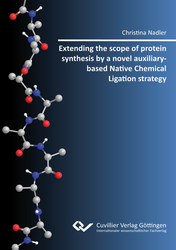| Areas | |
|---|---|
| Serie de libros (96) |
1378
|
| Nachhaltigkeit |
3
|
| Gesundheitswesen |
1
|
| Letra |
2363
|
| Ciencias Naturales |
5406
|
| Matemática | 229 |
| Informática | 319 |
| Física | 980 |
| Química | 1363 |
| Geociencias | 131 |
| Medicina humana | 243 |
| Estomatología | 10 |
| Veterinaria | 108 |
| Farmacia | 147 |
| Biología | 835 |
| Bioquímica, biología molecular, tecnología genética | 121 |
| Biofísica | 25 |
| Nutrición | 45 |
| Agricultura | 1004 |
| Silvicultura | 201 |
| Horticultura | 20 |
| Ecología y conservación de la tierra | 148 |
| Ciencias Ingeniería |
1791
|
| General |
98
|
|
Leitlinien Unfallchirurgie
5. Auflage bestellen |
|
Erweiterte Suche
Extending the scope of protein synthesis by a novel auxiliary‐based Native Chemical Ligation strategy (Tienda española)
Christina Nadler (Autor)Previo
Lectura de prueba, PDF (480 KB)
Indice, PDF (56 KB)
There is a constant need for developing improved methods for introducing artificial functionalities into peptides and proteins, as the modification of peptides and proteins is one of the major routes to investigate biological function in vitro and in vivo, e.g. by introduction of spin labels or fluorophores. To improve the synthetic accessibility of chemically modified peptides and proteins a new cysteine-free Native Chemical Ligation strategy based on a photocleavable auxiliary was developed and successfully implemented. In addition, a novel protocol for labeling peptides and proteins by introducing artificial, histidine-mimicking amino acids was devised. These triazole-based building blocks were utilized for the introduction of additional metal binding sites into peptides as well as for the development of peptidic zinc sensors based on zinc finger peptide Zif268.
| ISBN-13 (Impresion) | 9783954045044 |
| ISBN-13 (E-Book) | 9783736945043 |
| Formato | A5 |
| Idioma | Inglés |
| Numero de paginas | 198 |
| Laminacion de la cubierta | mate |
| Edicion | 1. Aufl. |
| Lugar de publicacion | Göttingen |
| Lugar de la disertacion | Göttingen |
| Fecha de publicacion | 18.09.2013 |
| Clasificacion simple | Tesis doctoral |
| Area |
Química
Química orgánica |
| Palabras claves | Organische Chemie, Peptidchemie, Festphasensynthese, SPPS, Native Chemical Ligation, cystein-freie Native Chemical Ligation, Ligationsauxiliar, Photolabilität, artifizielle Aminosäuren, Histidinmimetika, Single Amino Acid Chelate, Kupfer-katalysierte Azid-Alkin-Cycloaddition, Fluoreszenzspektroskopie, Zinksensoren, Zinkfingerpeptide, Zif268, Substratanalogon, Lipoxygenase. |








